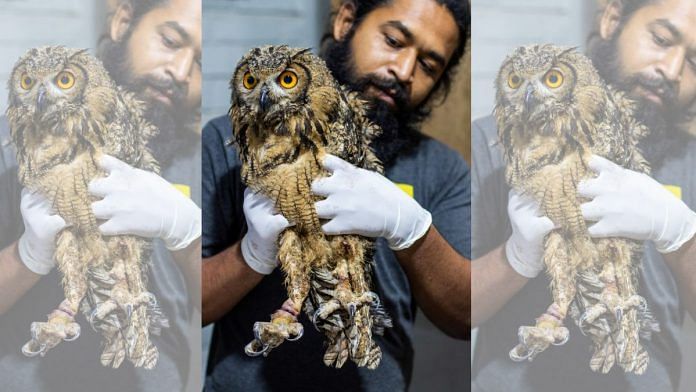A beautiful, mottled wood owl lay in front of my eyes, dead on arrival. It was sent to the RESQ wildlife treatment and rehabilitation centre by Satara forest department personnel who had recovered him from illegal captivity from an individual’s home after receiving a tip. It had damaged feathers, was severely dehydrated, and had bled out from the mouth before it succumbed.
While we light up our homes and lives this week, the festival is not so bright for several animals subjected to torture and death due to superstitious rituals on the auspicious days between Dusshera and Diwali—owls being one of the highest poached and sacrificed animals.
“We often get Indian eagle owls, mottled wood owls and other birds of prey like eagles and kites after they are subjected to superstitious rituals. Owls are generally caught in the wild, transported in bags and buckets by train or brought in with their legs tied tightly and talons chopped off,” says Tuhin Satarkar, director of the wildlife rescue unit at RESQ, Pune.
“Feathers, claws, heart, blood, eyes, beaks, eggshells, bones and, believe it or not, their tears, which are generally the watery discharge from their eyes when they are subjected to stress, are used for mystical rituals and black magic practices,” adds Satarkar.
According to Dr Sushrut Shirbhate, wildlife veterinarian at RESQ Charitable Trust, the recovery rate of owls subjected to illegal captivity or superstitious practices is entirely dependent on when they were rescued. Some of these rescued birds had cuts on their legs as they were tightly bound. “The rope or string used is often found cutting into the skin or embedded, which causes deep infection. These still recover. However, the ones who come in with limbs or wings cut and injured badly or severely dehydrated after being housed or transported in poor condition for days often do not make it,” he adds.
Also read: ‘To live is to kill’ — a Malabar pit viper and gliding frog affirm nature’s basic law
Why owls are sacrificed
There are several superstitious and contradicting beliefs surrounding owls. One school of thought believes that goddess Lakshmi, the Indian goddess of wealth, power, and splendour, when welcomed into our homes and worshipped on Diwali, should not be allowed to leave. To accomplish this, her Vahan or vehicle, the barn owl, must be destroyed or sacrificed. This way, the goddess’ presence and associated wealth remain in the home.
Owls are solitary and nocturnal birds, whose large-eyed stare, behaviour, and screeching calls are associated with bad luck, misfortune, or death. Another school of thought believes that the inauspicious Alakshmi—goddess Lakshmi’s elder twin sister who is considered her shadow opposite—accompanies her in a different form wherever she goes. Believers see the owl as a representation of this inauspicious form, and conspire to destroy it as a result.
Traditional healers and priests are also greatly responsible for creating a demand for body parts of raptors, which includes eagles, kites, and owls. They mislead individuals into believing that they can be cured of health problems or evil influences if they consume or use these parts in the riutals.
Dr Satish Pande, ornithologist and founder of Ela Foundation, recalls an incident where he came across young boys in a remote village in the Northeastern part of Maharashtra—extremely poor with barely any clothes on—carrying an owl in a bag with a catapult that they had used to capture it. On questioning them, they revealed that they were planning to eat the eyes of the owl, which would then enable them to see buried treasure. This is a bizarre explanation, but unfortunately, there are scores of myths like these that make owls a prime target for capture, trade, and unimaginable torture.
“The segment of society that believes in these myths is generally lured by conmen or superstitions in rural areas. The Ela Foundation organises and hosts the ‘Indian Owls Festival’ annually for the last two years in Ela Habitat at Pingori, Pune, where large-scale awareness programs are conducted with children and communities to bust myths and educate them about the ecological importance of owls,” says Pande.
Also read: Orphaned and exposed, why these Indian leopard cubs can’t return to the wild
Why you should give a hoot
India is home to over 35 species of owls, both resident and migratory. These nocturnal birds of prey play an extremely crucial role in maintaining ecological balance by feeding on rodents, reptiles, insects, and amphibians.
They are prolific rodent hunters and keep agrarian pest populations under control. Owls are protected in India under the Wildlife (Protection) Act 1972, which prohibits their hunting, trade, and utilisation in any form. Yet every year, owls are slaughtered for sacrifice, especially in rural areas and small towns in northeastern and central states of India.
While their ecological role remains grossly underappreciated by those indulging in superstitious acts, it is ironic that anyone believes they will attain good fortune by making an innocent animal suffer or die. The limited capacity of enforcement agencies to identify perpetrators makes this crime hard to detect.
If you are wondering how you can help, this Diwali, while you light up your homes and heart, take some time to spread awareness among those around you—especially people from smaller towns and villages who could’ve been potentially exposed to such misinformation.
Dispelling these myths, one person at a time can drive a simple message miles away, and an owl can possibly hoot safely in the darkness and peace of the night.
(Edited by Zoya Bhatti)



